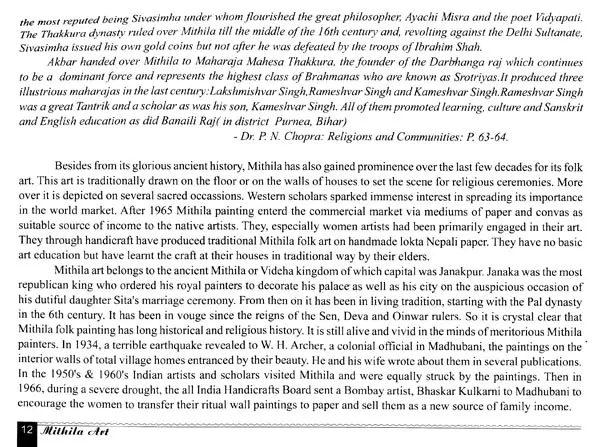
मिथिला लोक कला- Mithila Folk Art
Book Specification
| Item Code: | UAH120 |
| Author: | Ram Dayal Rakesh |
| Publisher: | Nepal Academy of Fine Arts |
| Language: | Nepali and English |
| Edition: | 2016 |
| ISBN: | 9789937259644 |
| Pages: | 104 (Throughout B/w Illustrations) |
| Cover: | PAPERBACK |
| Other Details | 7.00 X 9.50 inch |
| Weight | 160 gm |
Book Description
The myth of king Videh Janak- Videh meaning no attachment to his physical body, worldly wealth, power and pleasure - is related to his great-great Aryan grand-parents named Bidedha Madhav and Nimi, the former king established the country called Mithila-puri by crossing the river Narayani towards the end of Indus-valley (i.e. Sindh valley) civilization.
The glorious golden period of king shreedhwaj janak is described in the great epics - The Ramayan, The Mahabharat and the Upanishad known as Brihadaranyak (i.e. simply meaning thick and extensive jungle).
Thus, the origin of Mithila-art is rooted in the fertile soil of Mithila-now also known as Janakpur in Nepal and the Janak Dynasty.
As Aryans of Hindus the people of Mithila worshipped and are still worshipping the spiritual deities by invoking them with some MANTRAS (i.e. sacred hymns) before they start any work. Thus, in the beginning of the creative painter-artists drew/made the pictures of spiritual Gods, Goddesses, mythical characters, plants and various creatures with their deep sense and feeling of devotion, love, reverence to spiritual deities and with respect and affection to various creatures with some symbolic-meanings due to their spiritual faith in Pantheism.
The secret meaning of any figure, form, image, or symbol painted in the picture means well-being of individuals family, society, nation and the whole world, and on the other side it also means to ward off the evil spirits...
So, in every Mithila painting us as viewers can find the spiritual devotion, love, reverence, aspect, emotion, sentiment, aspirations, good-feeling of the art creators. Mithila-artists follow formalism and idealize the figures, forms, symbols and images, so this art appears to be idealistic and at the same-time classical. Thus, if the readers/viewers have some knowledge of basic Mithila iconography they will definitely find the Mithila-paintings meaningful, imbued with the spiritual and aesthetic feelings.
Mithila folk-paintings made on walls are like murals, and done on ground on festive occasions are like the performing acts with various purposes. But, because of the types of colors, materials and means used in the painting the history and development of this folk- at the same time classical art could not be properly recorded and documented in the past.
Now Mithila-artists are using canvas and papers along with permanent water or oil colors, so it has become easier to keep the records with the help of modem technical gadgets.
Finally, I feel the readers and the research scholars lovingly interested in Mithila-art may find this book interesting plus useful.
I willingly appreciate the perseverance of my friend and the author Ram Dayal Rakesh.
Book's Contents and Sample Pages













